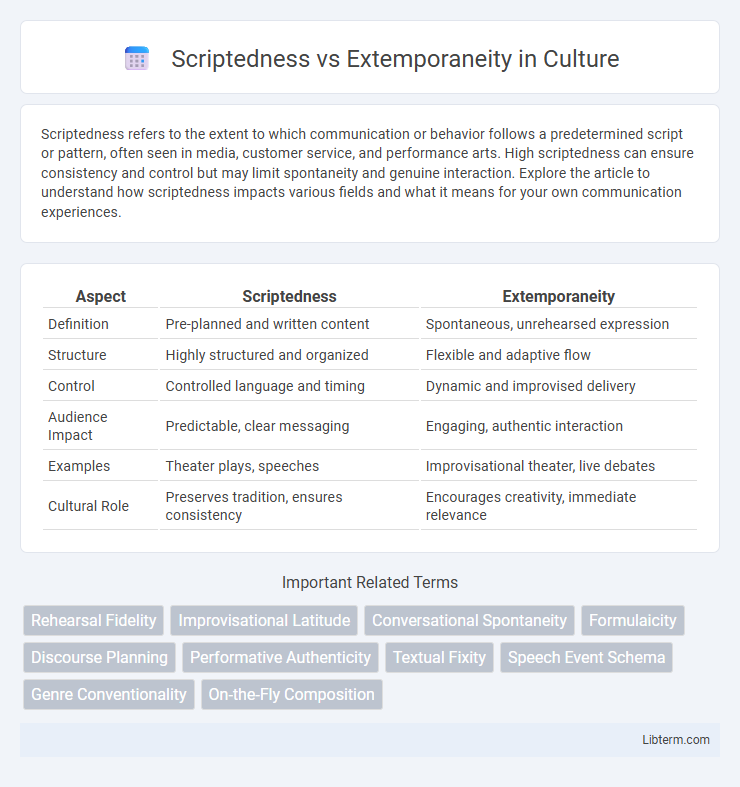Scriptedness refers to the extent to which communication or behavior follows a predetermined script or pattern, often seen in media, customer service, and performance arts. High scriptedness can ensure consistency and control but may limit spontaneity and genuine interaction. Explore the article to understand how scriptedness impacts various fields and what it means for your own communication experiences.
Table of Comparison
| Aspect | Scriptedness | Extemporaneity |
|---|---|---|
| Definition | Pre-planned and written content | Spontaneous, unrehearsed expression |
| Structure | Highly structured and organized | Flexible and adaptive flow |
| Control | Controlled language and timing | Dynamic and improvised delivery |
| Audience Impact | Predictable, clear messaging | Engaging, authentic interaction |
| Examples | Theater plays, speeches | Improvisational theater, live debates |
| Cultural Role | Preserves tradition, ensures consistency | Encourages creativity, immediate relevance |
Understanding Scriptedness and Extemporaneity
Scriptedness involves pre-planned, structured communication where language use follows predetermined scripts or texts, ensuring clarity and consistency. Extemporaneity emphasizes spontaneous, impromptu speech that adapts dynamically to context and audience, highlighting flexibility and real-time decision-making. Understanding the balance between scriptedness and extemporaneity is crucial in fields like communication, education, and performance to optimize message effectiveness and audience engagement.
Defining Scripted Communication
Scripted communication refers to interactions guided by pre-written texts or planned dialogue, ensuring consistency and clarity in messaging across various platforms. This method enhances precision in corporate presentations, customer service, and media broadcasts by reducing the risk of errors or miscommunication. Scripted communication contrasts with extemporaneous speech, which relies on spontaneity and adaptive responses rather than fixed wording.
Characteristics of Extemporaneous Speaking
Extemporaneous speaking features spontaneous delivery with minimal preparation, relying on a well-organized outline rather than a fully scripted text. Speakers maintain natural eye contact and adapt their message dynamically to audience reactions, enhancing engagement and clarity. This style demands strong topic mastery, quick thinking, and the ability to articulate ideas clearly without memorization.
Advantages of Scripted Interaction
Scripted interaction enhances communication clarity by ensuring messages are carefully crafted and consistently delivered, reducing misunderstandings in high-stakes environments. It allows for precise control over content, which is crucial in legal, medical, or corporate settings where accuracy and compliance with regulations are mandatory. Furthermore, scripted dialogue simplifies training processes and facilitates quality assurance through standardized responses.
Benefits of Extemporaneous Expression
Extemporaneous expression enhances authenticity by allowing speakers to adapt their message dynamically to audience reactions, fostering genuine engagement. This spontaneous approach promotes critical thinking and creativity, enabling immediate problem-solving and personalized responses. The flexibility of extemporaneous communication often results in a more relatable and impactful delivery than scripted presentations.
Scriptedness in Professional Settings
Scriptedness in professional settings enhances communication clarity by providing structured, rehearsed dialogue that minimizes misunderstandings and ensures consistent messaging. It supports strategic planning in presentations, negotiations, and customer interactions by enabling precise language tailored to specific objectives and audience expectations. Relying on scripted communication also improves efficiency in high-stakes environments such as corporate meetings, legal proceedings, and broadcast media, where accuracy and professionalism are paramount.
Extemporaneity in Creative Processes
Extemporaneity in creative processes emphasizes spontaneous, unplanned expression, fostering originality and authentic idea generation. This approach allows creators to adapt in real time, enhancing innovation by breaking free from rigid scripts or predetermined frameworks. As a result, extemporaneous methods promote dynamic problem-solving and fresh perspectives essential for artistic and intellectual breakthroughs.
Challenges of Scripted Speech
Scripted speech often faces challenges such as reduced spontaneity, leading to a less engaging delivery and difficulty adapting to audience feedback. Memorization demands can cause anxiety and disrupt natural flow, impeding authentic expression. Rigidity in pre-planned content limits the speaker's ability to modify messages in response to unexpected questions or changing contexts.
Overcoming Obstacles in Extemporaneous Delivery
Extemporaneous delivery demands quick thinking and adaptability to overcome obstacles such as unforeseen questions or technical difficulties. Mastery in organizing key points and practicing spontaneous elaboration enhances confidence and minimizes reliance on scripted content. Effective use of mental outlines and active audience engagement enables speakers to navigate interruptions and maintain clarity.
Finding the Balance: Scriptedness vs Extemporaneity
Finding the balance between scriptedness and extemporaneity is crucial for effective communication, as excessive scripting can hinder natural engagement while too much extemporaneity may lead to incoherence. Strategic use of scripted elements ensures clarity and precision, whereas spontaneous delivery enhances authenticity and audience connection. Optimal communication combines prepared key points with flexible adaptation to audience cues, maximizing impact and relatability.
Scriptedness Infographic

 libterm.com
libterm.com